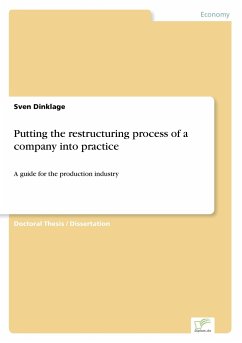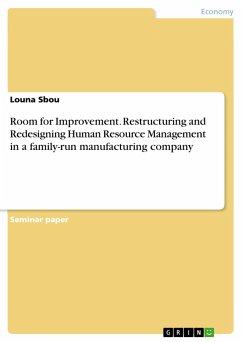Doctoral Thesis / Dissertation from the year 1997 in the subject Business economics - Personnel and Organisation, ESCP Europe Business School - Campus Madrid (Unbekannt), language: English, abstract: Inhaltsangabe:Abstract:
Companies in today's business world are under a constant pressure: they have to get as close as possible to the customer, they have to become ever more flexible and they need to reduce costs.
In order to face these challenges, some organisational structures are more likely to promise success than others. The characteristics of these structures are no secret, but companies often have the problem that they don't know how to put them into practice.
The present work is intended to give an answer to this question.
Having analysed what had been written about putting organisational change into practice 1 tested my ideas by a series of ten interviews which took place in companies of the German production sector. Six points were identified as essential: 16
. The problem and the objectives of the project should be clear for all participants.
2. The company should dispose of enough time and financial resources as well as a trusting
working climate and a supportive top and middle management.
3. Borderless communication is necessary, especially concerning the evolution of the change
project and the personal consequences for each person.
4. The employees should be able to participate actively in elaborating the change project, in decision-making and in identifying possibilities to stimulate motivation. This participation should be reflected in an adequate bonus system.
5. Continuous training for all (laying special attention an group leaders) is important an such areas as group work, communication and motivation.
The mentioned recommendations could be useful for the managers of companies which are thinking about a reorganisation. That would enable them to avoid mistakes made by other companies.
The following mistakes were the most important ones:
Impatience and the expectation that there will be a 'magic solution' (it might take up to five years to reach the desired state).
The non-implication of the workforce in introducing the change process (result: the project is being blocked from their side).
Lack of communication which creates rumours about the coming change process (result: anxiety is created and the best workers will try to find another job).
Out of date bonuses which are not favourable in order to reach the company's global
objectives (such as individual bonuses and 'competition stimulators' between groups).
Inhaltsverzeichnis:Table of Contents:
FOREWORD5
EXECUTIVE SUMMARIES6
Summary6
Résumé7
Resumen8
Zusammenfassung9
PART I. - INTRODUCTION10
I.ATHE ORIGINAL QUESTION10
I.BOBJECTIVES10
I.CMETHODOLOGY11
I.C.a)ABOUT THE METHODOLOGY OF THIS PAPER11
I.C.b)CHOICE OF TARGET COMPANIES FOR THE INTERVIEWS12
I.C.c)METHODOLOGY OF INTERVIEWS12
I.C.d)DATA ANALYSIS AND PRESENTATION13
I.C.e)LIMITATIONS OF THE EMPIRICAL METHODOLOGY13
I.DINTERNATIONAL RELEVANCE OF THIS WORK14
PART II.- RESEARCH15
II.ALITERATURE RESEARCH15
II.A.a)CHANGE AND RESISTANCE15
- Partial conclusions - fighting resistance by openness18
II.A.b)DECENTRALISATION19
- Partial conclusions - adapting leadership to a decentralised structure21
II.A.c)LEADERSHIP22
- Partial conclusions - the key role of the leader22
II.A.d)VISION23
- Partial conclusions - a shared vision will bring people together23
II.A.e)PARTICIPATION24
- Partial conclusions - bring responsability down25
II.A.f)TRUST25
- Partial conclusions - a trustful relationship helps26
II.A.g)MISTAKES AND THE LEARNING ORGANISATION 26
- Partial conclusions - mistakes are useful...
Hinweis: Dieser Artikel kann nur an eine deutsche Lieferadresse ausgeliefert werden.
Companies in today's business world are under a constant pressure: they have to get as close as possible to the customer, they have to become ever more flexible and they need to reduce costs.
In order to face these challenges, some organisational structures are more likely to promise success than others. The characteristics of these structures are no secret, but companies often have the problem that they don't know how to put them into practice.
The present work is intended to give an answer to this question.
Having analysed what had been written about putting organisational change into practice 1 tested my ideas by a series of ten interviews which took place in companies of the German production sector. Six points were identified as essential: 16
. The problem and the objectives of the project should be clear for all participants.
2. The company should dispose of enough time and financial resources as well as a trusting
working climate and a supportive top and middle management.
3. Borderless communication is necessary, especially concerning the evolution of the change
project and the personal consequences for each person.
4. The employees should be able to participate actively in elaborating the change project, in decision-making and in identifying possibilities to stimulate motivation. This participation should be reflected in an adequate bonus system.
5. Continuous training for all (laying special attention an group leaders) is important an such areas as group work, communication and motivation.
The mentioned recommendations could be useful for the managers of companies which are thinking about a reorganisation. That would enable them to avoid mistakes made by other companies.
The following mistakes were the most important ones:
Impatience and the expectation that there will be a 'magic solution' (it might take up to five years to reach the desired state).
The non-implication of the workforce in introducing the change process (result: the project is being blocked from their side).
Lack of communication which creates rumours about the coming change process (result: anxiety is created and the best workers will try to find another job).
Out of date bonuses which are not favourable in order to reach the company's global
objectives (such as individual bonuses and 'competition stimulators' between groups).
Inhaltsverzeichnis:Table of Contents:
FOREWORD5
EXECUTIVE SUMMARIES6
Summary6
Résumé7
Resumen8
Zusammenfassung9
PART I. - INTRODUCTION10
I.ATHE ORIGINAL QUESTION10
I.BOBJECTIVES10
I.CMETHODOLOGY11
I.C.a)ABOUT THE METHODOLOGY OF THIS PAPER11
I.C.b)CHOICE OF TARGET COMPANIES FOR THE INTERVIEWS12
I.C.c)METHODOLOGY OF INTERVIEWS12
I.C.d)DATA ANALYSIS AND PRESENTATION13
I.C.e)LIMITATIONS OF THE EMPIRICAL METHODOLOGY13
I.DINTERNATIONAL RELEVANCE OF THIS WORK14
PART II.- RESEARCH15
II.ALITERATURE RESEARCH15
II.A.a)CHANGE AND RESISTANCE15
- Partial conclusions - fighting resistance by openness18
II.A.b)DECENTRALISATION19
- Partial conclusions - adapting leadership to a decentralised structure21
II.A.c)LEADERSHIP22
- Partial conclusions - the key role of the leader22
II.A.d)VISION23
- Partial conclusions - a shared vision will bring people together23
II.A.e)PARTICIPATION24
- Partial conclusions - bring responsability down25
II.A.f)TRUST25
- Partial conclusions - a trustful relationship helps26
II.A.g)MISTAKES AND THE LEARNING ORGANISATION 26
- Partial conclusions - mistakes are useful...
Hinweis: Dieser Artikel kann nur an eine deutsche Lieferadresse ausgeliefert werden.








